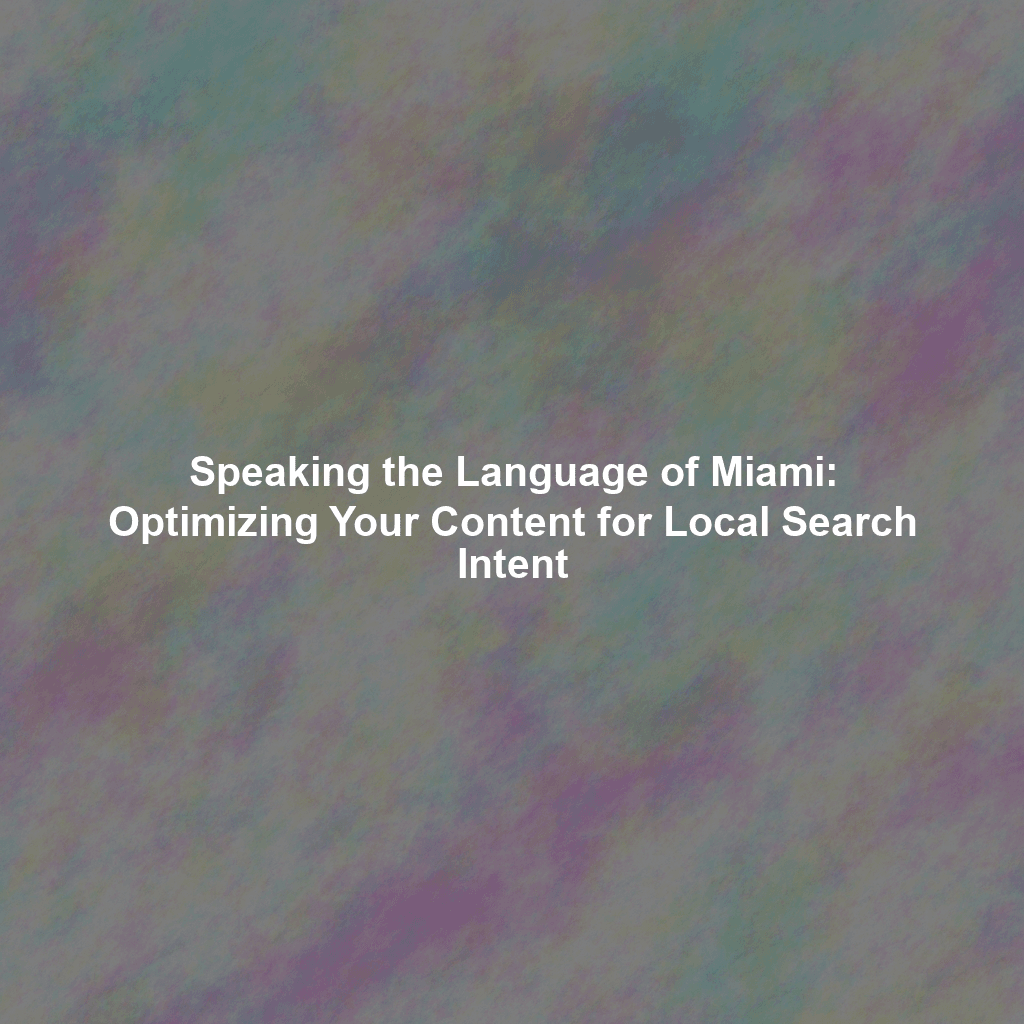Miami, a vibrant melting pot of cultures, boasts a unique identity. Its language is a colorful blend of English and Spanish, infused with local slang and cultural nuances. For small businesses in Miami, understanding and incorporating this linguistic landscape into your website content is crucial for effective Local SEO. Simply put, to truly connect with Miami residents and rank higher in local search results, you need to speak their language.
Understanding the Miami Demographic: More Than Just Spanish
While Spanish is undeniably prevalent, assuming everyone speaks it fluently is a mistake. Miami’s demographic is incredibly diverse, including long-time residents, recent immigrants, and seasonal visitors. Therefore, your content strategy needs to be multifaceted.
Identifying Your Target Audience within Miami
Before diving into language, pinpoint your specific target audience. Are you catering to young professionals in Brickell? Families in Doral? Tourists in South Beach? Each group may have different linguistic preferences and search habits.
Acknowledging the Spanglish Influence
Spanglish, a blend of Spanish and English, is widely spoken and understood. However, using it effectively in your content requires finesse. Overdoing it can sound forced or even offensive. Authenticity is key.
Keyword Research: Thinking Like a Miamian
Traditional keyword research tools are a good starting point, but they often miss the local flavor. Consider these approaches:
Leveraging Local Slang and Colloquialisms
Miami has its own unique slang terms. For example, instead of searching for “cheap eats,” someone might search for “buenos y baratos restaurants Miami.” Research local forums, social media groups, and review sites to identify commonly used phrases.
Optimizing for Spanish Language Searches
Don’t just translate your English keywords into Spanish. Conduct separate keyword research in Spanish to uncover terms that Spanish speakers in Miami actually use. Consider common misspellings and variations as well. For instance, someone looking for a “peluqueria” (hair salon) might also search for “barberia.”
Considering Neighborhood-Specific Keywords
Incorporate neighborhood names into your keywords. Instead of just “best pizza,” try “best pizza in Little Havana” or “pizza delivery in South Beach.” This helps target users searching for businesses specifically in their area.
Creating Content that Resonates: Authenticity Matters
Once you have your keywords, craft content that is both informative and engaging, while reflecting the Miami lifestyle.
Infusing Local Culture into Your Content
Reference local events, landmarks, and cultural traditions. For example, if you’re promoting a restaurant, mention its proximity to Calle Ocho or its Cuban sandwich specials. This signals to users (and Google) that you understand the Miami context.
Addressing Local Concerns and Interests
Tailor your content to address the specific needs and interests of Miami residents. This could include information about hurricane preparedness, traffic updates, or tips for navigating the city’s unique challenges.
Using Images and Videos that Reflect Miami
Visual content is just as important as written content. Use high-quality images and videos that showcase Miami’s vibrant scenery, diverse communities, and unique culture. Avoid generic stock photos that could be from anywhere.
Optimizing for Spanish Language: A Dual Language Strategy
Having a Spanish version of your website is essential, but it’s not just about translation. It’s about creating a truly bilingual experience.
Implementing Hreflang Tags
Use hreflang tags to tell Google which language version of your page should be shown to users based on their language and location. This is crucial for avoiding duplicate content issues and ensuring that users see the most relevant version of your site.
Offering a Seamless Bilingual User Experience
Make it easy for users to switch between English and Spanish versions of your website. A clear language selector is a must-have. Ensure all elements, including menus, forms, and call-to-actions, are fully translated.
Investing in Professional Translation and Localization
Avoid using automated translation tools alone. They often produce inaccurate and unnatural-sounding results. Invest in professional translation and localization services to ensure that your Spanish content is grammatically correct, culturally appropriate, and optimized for search.
Measuring Your Success and Adapting Your Strategy
Track your website’s performance in both English and Spanish search results. Monitor key metrics such as website traffic, keyword rankings, and conversion rates. Analyze the data to identify areas for improvement and refine your content strategy accordingly.
Using Google Analytics to Track Language Performance
Google Analytics can help you track which language version of your website is performing best and identify which keywords are driving the most traffic. Set up goals to measure conversions from both English and Spanish users.
Monitoring Local Search Rankings for Spanish Keywords
Use a local search tracking tool to monitor your rankings for Spanish keywords in Miami. This will help you identify areas where you need to improve your optimization efforts.
Conclusion: Connecting with the Heart of Miami
In Miami, speaking the local language isn’t just about grammar and vocabulary; it’s about understanding the culture, embracing the diversity, and connecting with the heart of the community. By tailoring your website content to reflect the linguistic and cultural nuances of Miami residents, you can significantly improve your Local SEO performance, attract more customers, and build a stronger brand presence in this dynamic city. Embrace the Spanglish, the local slang, and the vibrant spirit of Miami, and watch your business flourish.
 Skip to content
Skip to content

